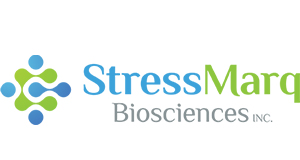Alpha Synuclein Monomers (Type 1)
Human Recombinant Alpha Synuclein Protein Monomers (Type 1)
Artikelnummer
STRSPR-321XE
Verpackungseinheit
500 µg (@5mg/ml)
Hersteller
Stressmarq Biosciences
Verfügbarkeit:
wird geladen...
Preis wird geladen...
Target: Alpha Synuclein
Nature: Recombinant
Swiss-Prot: P37840
Biological Activity: 100 µM alpha synuclein protein monomer (SPR-321) seeded with 10 uM alpha synuclein PFFs (SPR-322) in 25 µM Thioflavin T (PBS pH 7.4, 100 µl reaction volume) generated a fluorescence intensity of 13,000 Relative Fluorescence Units after incubation at 37°C with shaking at 600 rpm. Fluorescence was measured by excitation at 450 nm and emission at 485 nm on a Molecular Devices Gemini XPS microplate reader.
Expression System: E. coli
Protein Length: Full Length
Amino Acid Sequence: MDVFMKGLSK AKEGVVAAAE KTKQGVAEAA GKTKEGVLYV GSKTKEGVVH GVATVAEKTK EQVTNVGGAV VTGVTAVAQK TVEGAGSIAA ATGFVKKDQL GKNEEGAPQE GILEDMPVDP DNEAYEMPSE EGYQDYEPEA
Purification: Ion-exchange Purified
Purity: >95%
Storage Buffer: PBS pH 7.4
Protein Size: ~14.46 kDa
Conjugate: No tag
Cellular Localization: Cytoplasm / Membrane / Nucleus
Scientific Background: Alpha-Synuclein (SNCA) is expressed predominantly in the brain, where it is concentrated in presynaptic nerve terminals (1). Alpha-synuclein is highly expressed in the mitochondria of the olfactory bulb, hippocampus, striatum and thalamus (2). Functionally, it has been shown to significantly interact with tubulin (3), and may serve as a potential microtubule-associated protein. It has also been found to be essential for normal development of the cognitive functions; inactivation may lead to impaired spatial learning and working memory (4). SNCA fibrillar aggregates represent the major non A-beta component of Alzheimers disease amyloid plaque, and a major component of Lewy body inclusions, and Parkinson's disease. Parkinson's disease (PD) is a common neurodegenerative disorder characterized by the progressive accumulation in selected neurons of protein inclusions containing alpha-synuclein and ubiquitin (5, 6).
References: 1. “Genetics Home Reference: SNCA”. US National Library of Medicine. (2013).2. Zhang L., et al. (2008) Brain Res. 1244: 40-52.3. Alim M.A., et al. (2002) J Biol Chem. 277(3): 2112-2117.4. Kokhan V.S., Afanasyeva M.A., Van'kin G. (2012) Behav. Brain. Res. 231(1): 226-230.5. Spillantini M.G., et al. (1997) Nature. 388(6645): 839-840.6. Mezey E., et al. (1998) Nat Med. 4(7): 755-757.
Field of Use: Not for use in humans. Not for use in diagnostics or therapeutics. For research use only.
Nature: Recombinant
Swiss-Prot: P37840
Biological Activity: 100 µM alpha synuclein protein monomer (SPR-321) seeded with 10 uM alpha synuclein PFFs (SPR-322) in 25 µM Thioflavin T (PBS pH 7.4, 100 µl reaction volume) generated a fluorescence intensity of 13,000 Relative Fluorescence Units after incubation at 37°C with shaking at 600 rpm. Fluorescence was measured by excitation at 450 nm and emission at 485 nm on a Molecular Devices Gemini XPS microplate reader.
Expression System: E. coli
Protein Length: Full Length
Amino Acid Sequence: MDVFMKGLSK AKEGVVAAAE KTKQGVAEAA GKTKEGVLYV GSKTKEGVVH GVATVAEKTK EQVTNVGGAV VTGVTAVAQK TVEGAGSIAA ATGFVKKDQL GKNEEGAPQE GILEDMPVDP DNEAYEMPSE EGYQDYEPEA
Purification: Ion-exchange Purified
Purity: >95%
Storage Buffer: PBS pH 7.4
Protein Size: ~14.46 kDa
Conjugate: No tag
Cellular Localization: Cytoplasm / Membrane / Nucleus
Scientific Background: Alpha-Synuclein (SNCA) is expressed predominantly in the brain, where it is concentrated in presynaptic nerve terminals (1). Alpha-synuclein is highly expressed in the mitochondria of the olfactory bulb, hippocampus, striatum and thalamus (2). Functionally, it has been shown to significantly interact with tubulin (3), and may serve as a potential microtubule-associated protein. It has also been found to be essential for normal development of the cognitive functions; inactivation may lead to impaired spatial learning and working memory (4). SNCA fibrillar aggregates represent the major non A-beta component of Alzheimers disease amyloid plaque, and a major component of Lewy body inclusions, and Parkinson's disease. Parkinson's disease (PD) is a common neurodegenerative disorder characterized by the progressive accumulation in selected neurons of protein inclusions containing alpha-synuclein and ubiquitin (5, 6).
References: 1. “Genetics Home Reference: SNCA”. US National Library of Medicine. (2013).2. Zhang L., et al. (2008) Brain Res. 1244: 40-52.3. Alim M.A., et al. (2002) J Biol Chem. 277(3): 2112-2117.4. Kokhan V.S., Afanasyeva M.A., Van'kin G. (2012) Behav. Brain. Res. 231(1): 226-230.5. Spillantini M.G., et al. (1997) Nature. 388(6645): 839-840.6. Mezey E., et al. (1998) Nat Med. 4(7): 755-757.
Field of Use: Not for use in humans. Not for use in diagnostics or therapeutics. For research use only.
| Artikelnummer | STRSPR-321XE |
|---|---|
| Hersteller | Stressmarq Biosciences |
| Hersteller Artikelnummer | SPR-321XE |
| Verpackungseinheit | 500 µg (@5mg/ml) |
| Mengeneinheit | STK |
| Reaktivität | Human |
| Methode | Western Blotting, In Vivo Assay, SDS-PAGE |
| Human Gene ID | 6622 |
| Produktinformation (PDF) | Download |
| MSDS (PDF) | Download |

 English
English










